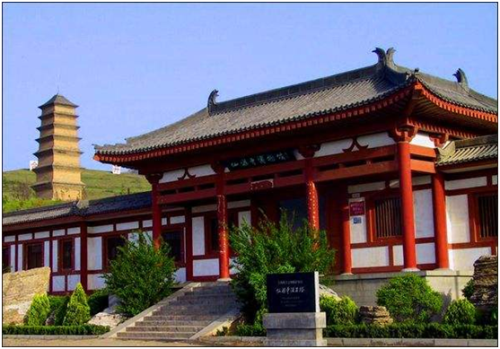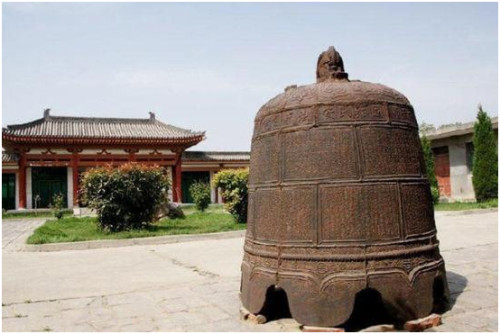- CURRENT LOCATION: HOME
- >> Tourism
- >> Attractions in Cities
- >>
- Xi'an
Xianyou Temple Museum
2021-10-19 17:32:00 , Source : The Government Website of Shaanxi Province
Xianyou Temple Museum is situated in Mazhao Town, Zhouzhi County, and 53.4 miles (86 kilometers) southwest of the provincial capital city Xi’an. Owing to the history that says Emperor Wen of the Sui Dynasty (581 – 618) once built a pagoda there to settle Buddha Relics as well as being the birthplace of Chinese classical poetry The Everlasting Regret by Bai Juyi (772-846), it has long been regarded as a famous tourism site.
Before 2001, there was no museum, just the Temple itself. Then, in the process of the local reservoir construction, the temple was relocated. As a large number of precious cultural relics were found during the relocation, the government decided to establish a museum to preserve the historical relics and the temple, hence Xianyou Temple Museum was built on the previous Zhouzhi County Administration of Cultural Relics. Now in the museum, there are Sarira Pagoda, the temple and some important historical relics under special preservation.
The temple has a very long history. It was built in the Sui Dynasty in 598, during the Emperor Wen (Yang Jian) period (581 – 600). The Emperor Wen was going on an inspection tour at that time. When he came to this area, he was delighted with the beautiful scenery of the place and ordered a palace to be built and named it Xianyou Palace. As its name implied, it was a place for the emperor to have entertainment. Then in 601, Emperor Wen ordered a pagoda to be constructed in the palace to settle the Buddha relics, which is the Sarira Pagoda. From then on, the palace was renamed as Xianyou Temple. Since then, the temple was renamed and repaired several times, but still remained known as Xianyou Temple till today.

The temple consists of a main hall of the Qing Dynasty (1636 – 1912AD). In both sides of the main hall, stands a side room. Next to the side rooms, there are about 20 wing rooms. In front of the main hall, stand an iron bell made in the Ming Dynasty (1368 – 1644AD); inside the main hall, preserve clay Buddha. 44 yards (40 meters) east to the main hall, stands a Lama Style pagoda with a square base. Sarira Pagoda is located 66 yards (60 meters) northwest to the main hall; with seven floors, it is about 115 feet (35 meters) high. In Yang Jian’s reign, he built 113 pagodas all around the country; Sarira Pagoda in Xianyou Temple is the only one existing till today.
Besides the temple and Sarira Pagoda, the two-storey museum building in Tang Dynasty (618 - 907 AD) style has been opened for the public in the scenic area.
Covering an area of 240 square yards (200 square meters), the museum preserves 302 pieces of historical relics and four permanent exhibitions are held inside year round.
1. Sarira Pagoda cultural relics
They are preserved in the main exhibition room of the museum. There are 102 pieces of historical relics in total, including Sarira Pagoda cultural relics and exhibits of other time periods. Sarira Pagoda cultural relics, as the name suggests, are exhibits related to the Buddha. Among the exhibits, there are sarcophagus, gilding bronze coffins, Phials, and some Buddha Relics. Besides, there is an Incense Burner, a stele of the pedestal of the Sarira Pagoda, and seven precious stone stele rubbings. These exhibits are very valuable for understanding and research of the development of Buddhism and painting art in Sui and Tang Dynasties. The other exhibitions are cultural relics unearthed around the original Xianyou Temple from Longshan Period (about 4500 years before) to the Qing Dynasty. Stone vessels, bone implements, pottery, porcelain, jade article, silverware, etc, fully reflect the achievement in art and science of the local people.
2. Ancient and modern steles
As a historical site came into being in Sui and Tang Dynasties, the temple always has charm for the ancient scholars. It attracted many famous poets, painters and calligraphers to come and find their inspiration. Among them, the most famous is Ba Juyi, who created the Chinese classical poetry The Everlasting Regret in the temple in 706. Stone steles of calligraphy of The Everlasting Regret from different time periods are now highlights of the temple; each of them has its own distinctive features. They enriched the exhibition content in the museum. In addition, the museum now has an iron bell of epigraph, 19 ancient stone steles, and 25 modern and contemporary celebrities’ inscriptions. To understand the long history of this temple and the background as well as the artistic charm of The Everlasting regret, this museum is the best place to go.
3. Words & pictures of the relocation and reconstruction of Xianyou Temple
The pictures and other historical materials here reflect the features and influence of the temple before and after the relocation. Through this exhibit, tourists will have a better understanding of the temple's history.
4. Paintings and calligraphies of Korean Art & Writers Association
Cultural exchange activities between China and South Korea have been held four times in the temple. Now there are more than 40 pieces of paintings by Korean artists in the museum.
In addition to its historical charms, the natural scenery around is beautiful. Looking into the distance, one can watch the lofty Qinling Mountains, covered by green trees and thick mist. The Black River National Forest Park is located near the temple. Besides, it is said that the love story of the idiom “a proud son-in-law” happened there, which adds mysterious color to the temple.

How to get to Xianyou Temple Museum
Take bus from Xi’an Bus Station located on Fengqing Road to Zhouzhi Bus Station, which is available from 7:00 to 17:00 and it costs CNY23.5. After arrival, hire a car to get there at about CNY50.
Admission Fee | CNY15 |
Opening Time | 8:00-18:00 |

Government Organizations



Other Links

Copyright@www.shaanxi.gov.cn All Rights Reserved
Registration Number:陕ICP备10004160号
